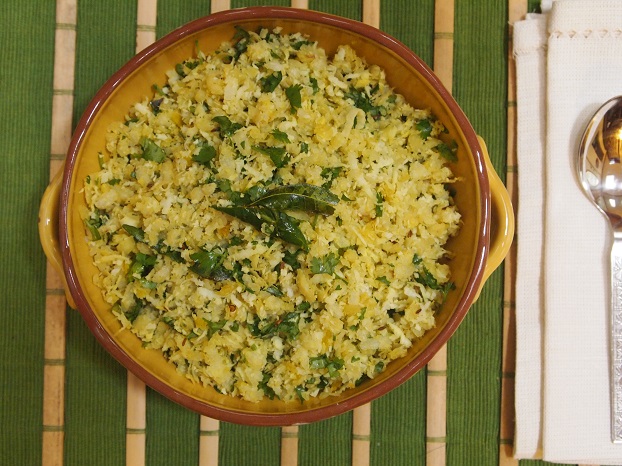
The recipes for many of the dishes my children relish were crafted in a kitchen they have never set foot in. They’ve never met their great-grandmother, Shakuntala Bai, who concocted the dishes much-loved by their father and uncles when they were growing up. They’ve never seen first-hand the implements or witnessed the methods she used to conjure up delicacies they now enjoy. But they do have stories. Stories lovingly and proudly told by their paternal grandmother whose hands now follow in the trajectory forged by her own mother all those years ago.
The dishes I most associate with Shakuntala Bai and her kitchen are the ones made of avalakki or poha, the feathery flakes of parboiled, dried and flattened rice. I grew up eating a couple of varieties of avalakki dishes in my parents’ home, but Shakuntala Bai’s kitchen produced an unending variety — avalakki made with onions, lemon, tamarind, coconut, with many vegetables together or with just bell pepper, or with a combination of spices; avalakki that ran the gamut from dry to just dampened with fresh coconut to soaked in water, milk or buttermilk, to roasted or fried, to mixed with chutney powders.
The variety was breathtaking, the occasions for making and eating avalakki seemingly endless — to pack for travel, to serve to guests that came without notice (which was almost always the case), to give as a gift during festivals, to eat as snack when the children returned from school, as breakfast and to break a fast.
Even more fascinating is that the stories of Shakuntala Bai’s kitchen and her strict rules for running it evoke images of an increasingly rare way of life. Before we go on to her recipes for Kayi Avalakki (Coconut Avalakki) and Onion Avalakki, here’s a peek into a day in the life of her kitchen.
A Peek Into The Past: A Day In The Life Of Shakuntala Bai’s Kitchen
Fresh from her bath, her hair still damp, draped in one of her saris that she’s reserved for use only while cooking, Shakuntala Bai bustles into the kitchen — tucked into the area between the bath and the prayer room — her mind whirling with all the tasks at hand that will spring her kitchen to life. She must hurry because her husband, Srinivasa Rao, is waiting for her to finish cooking so he can begin his daily prayer rituals. He fasts every morning until the time he finishes his prayers.
She first lights the one coal stove in her kitchen she uses for slow cooking and sets some dal to boil in a dal gundi, a round-bottomed brass vessel. All her vessels are made of brass and the insides cleaned and polished to blinding so they don’t react with the spices. Then she turns to one of the four other stoves, each one a size different from the other, but all of them lit by firewood.
Shakuntala Bai picks one depending on what dish she plans to cook next. She carefully places a few dung pies inside the circular enclosure, pours some kerosene over them, lights them with a matchstick and when the fire is roaring, she adds firewood one log at a time. Once or twice she picks up a long metal pipe, inserts one end into the waning flames and blows air from the other end to coax the fire back to life.
When the fire is good and ready and a quick wash of the hands later, Shakuntala Bai puts on some water to boil — water stored in a tank in a corner of the kitchen and to be used only for cooking. She readies the large cast iron pan on which she will make chapattis or bhakris (rotis made of jowar flour). She walks over to one of the shelves carved into the wall where she stores her grains and other groceries, and picks up some flour in a vessel and adds a little bit of salt. Then she squats on the floor in front of the stove and kneads flour with the hot water and salt for bhakris.
Once she finishes prepping the dough, Shakuntala Bai places the cast iron pan on the stove, checks the fire and fiddles with it a little until she’s satisfied. She moves a little so she’s in front of the large, round, smooth Shahbaz stone placed strategically near the stove. She flours the surface and pats small balls of the dough into circular shapes on the stone, her palm going pat, pat, pat on the stone, constantly moving in quick semi-circles so the bhakris turn out evenly round. With darting movements, her fingers dab drops of water on the now expanding circle to fix cracks and then some flour so it doesn’t get stuck on the stone. Water, flour, water, pat, pat, pat. A white cloud of fine flour dust swirls in the air around her.
By this time, Shakuntala Bai’s kitchen is humming. The dal bubbles softly, perhaps there’s milk boiling on one of the other stoves, fires crackle under the various vessels and pans, her hands and bangles providing a steady rhythm to the melody.
Much of the space and implements in Shakuntala Bai’s kitchen are off-limits to anyone but herself, but she will allow her daughters to cut vegetables, crush the dry spice ingredients for the spice powders and the chutney powders (dry chutney condiments) or sift flour — anything that does not involve touching or adding water.
Under her instructions, they gather vegetables from a large, round wire basket placed next to the butter churner. For chopping the vegetables they must use the iligé mané — a rectangular block of wood to which a concave blade with a circular serrated edge is screwed on at one end.
Whoever happens to be cutting that day settles down on the floor with the right leg folded in and the knee resting on the wooden block to hold it in place, and the left leg bent at the knee and resting on the floor. Then they chop the vegetables as necessary — diced into small or large pieces or sliced, the vegetables falling into a vessel placed underneath the blade. With repeated tries, they even perfect the art of dicing cucumbers finely for raithas — they slice length-wise thinly about three inches deep, then flip the cucumber horizontally and slice it through the blade for pieces tiny enough to go in a raitha.
There are no knives or cutting boards or peelers in Shakuntala Bai’s kitchen, but there is a fantastic implement that stands in as a peeler. She is the owner of a collection of large sea shells — you read that right, sea shells! — all pared down on one end on a sandalwood stone until they are sharp enough to peel the skins off vegetables.
Another of the daughters crushes the dry ingredients to make the spice blend for rasam or huli (savory dal gravies with tomatoes and vegetables, respectively, to be eaten with rice), as the case may be, on the kabbath, her arms pushing and pulling the oval-shape stone over the rectangular stone base, pausing once in a while to scoop errant peppercorns and coriander seeds back between the base and the rolling stone.
When the last of the bhakris comes off the pan, Shakuntala Bai moves on to the other dishes. She adds vegetables, tamarind juice, salt, and red chili powder to finish cooking the dal. If chutney is on the menu, because there’s water involved, she grinds the ingredients in her grinding stone herself. Finally, she makes a batch of tempering in a round pan that she will spoon on the dal and chutney.
At last she is done. She extinguishes the fires. From her shelf she brings down a pathroli (a round plate made of dried leaves held together with the help of tiny, tiny sticks) and a donné (a cup made of dried plantain leaves), spoons small portions of all the dishes she has made that morning and takes them to her husband in the prayer room. They will form part of the ritual prayer offerings for that day. The rules of madi (purity) do not allow her to use steel plates or cups to serve food in her home.
When the fires have died down completely, Shakuntala Bai cleans out the stoves and moves the coal from the wood-burning stoves into a pit in the corner of the bathroom for storage.
Shakuntala Bai’s daughters watch her every move, pitching in as much as their mother’s rules and tradition allow them to, learning from her actions and movements as she did from her mother and mother-in-law.
* * *
Recipes
Avalakki is a staple in North Karnataka cuisine. Avalakki Uppittu, a type of semi-dry porridge, is a popular breakfast dish. The rice flakes are also used to make quick snacks eaten late in the afternoon. A few basic spices and ingredients are all it takes to turn avalakki into dishes that are flavorful but light. More elaborate preparations of avalakki (such as Chivda) are made once in a while in large quantities to pack and take while travelling or to share among family and guests during festivals and religious observations.
Avalakki is available in three varieties — thin, medium and thick — and is sold in Indian grocery stores as poha. The thin and medium varieties (and a super thin version known as ‘nylon’ avalakkki) are ideal for dishes that do not require the avalakki to be soaked in water. The thick variety is called for in dishes such as Avalakki Uppittu where the pressed rice flakes will be soaked in water before being steamed with spices and vegetables.
Both the recipes below use thin avalakki. If you can find the nylon variety, do use that. If not, thin avalakki will work just fine.
Curry leaves are leaves of the curry leaf plant (a full-grown plant almost gets up to the size of a tree) and are mainly used in tempering but dried curry leaves are also used to make chutney powder. Most people pick the leaves out and do not eat them, but if you do want to eat them, they are flavorful and have wonderful digestive properties. If you are not able to find fresh curry leaves, you can substitute the dried variety.
Kayi Avalakki (Coconut Avalakki)
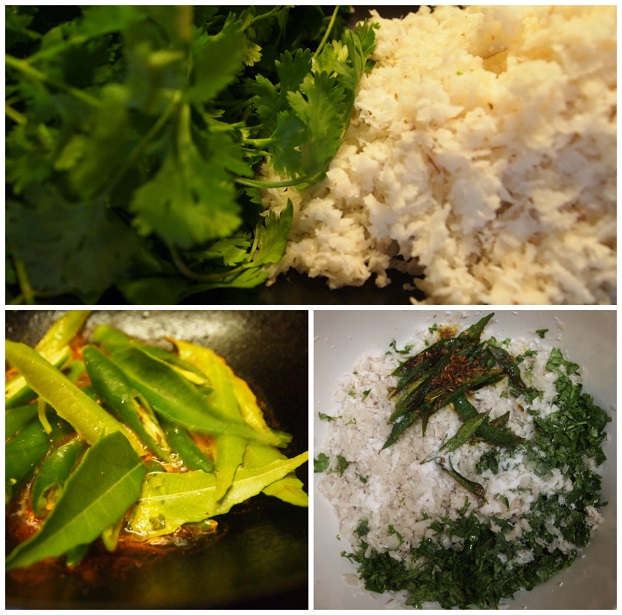
Makes 2 servings for breakfast or 4 servings for a late afternoon snack. Fresh, unsweetened grated coconut is key. The moisture from the fresh coconut softens the avalakki (even paper thin ones need some softening). This recipe carries a strong lemony flavor. Adjust the amount of lemon juice to your taste.
Ingredients:
4 cups thin avalakki, cleaned (see tip below)
1 whole fresh coconut, grated (or about 2 cups frozen grated unsweetened coconut, thawed)
¼ cup lemon juice (or to taste)
½ cup chopped coriander leaves
2 tsp sugar
Salt to taste
Tempering:
3 tsp vegetable oil
1 tsp cumin
¼ tsp turmeric
¼ tsp asafetida
8 curry leaves
4 green chilies slit lengthwise (and deseeded if you don’t want the dish spicy)
Method:
In a serving bowl mix together avalakki and grated coconut and set aside for 20 minutes. Blend the two gently but firmly with your fingers.
In a small frying pan or a small cast iron wok, heat the oil until shimmering. Add cumin. Once the cumin is roasted (about 20 seconds; the aroma is hard to miss), add the turmeric and asafetida and give it a quick stir. Then add the curry leaves and green chilies and sauté for a few seconds. Take care when adding the curry leaves and green chilies as they will splatter when added to hot oil. Remove the frying pan from the fire. Pour the tempering into the bowl with the avalakki and coconut along with rest of the ingredients. Add lemon juice a little at a time. Mix thoroughly but lightly with two large spoons.
Serve immediately in bowls.
Onion Avalakki
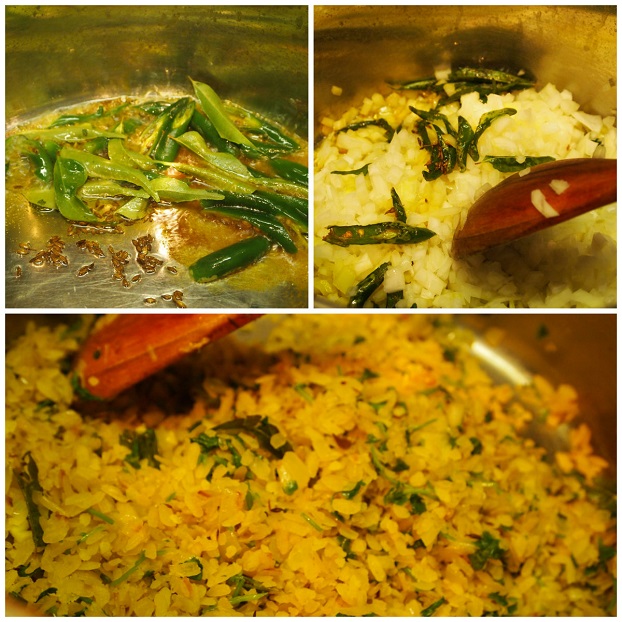
Makes 6 servings. If you love onions, then this is a dish you must try. Roasted onions complement the slightly crunchy pressed rice. It might seem like a lot of onions when you see them all chopped up, but once roasted, the onions reduce in quantity quite a bit. Take care to roast them on a medium to low flame so as not to burn or discolor them as neither the aroma nor the look of burned onions is appetizing.
Tempering:
3 tbsp oil
½ tsp cumin
¼ tsp turmeric
8 curry leaves
5 green chilies, slit lengthwise (and deseeded if you don’t want the dish spicy)
Ingredients:
5 cups thin avalakki, cleaned (see tip in the recipe for Kayi Avalakki)
3 cups finely chopped yellow onions
Salt to taste (about 1tsp)
¼ cup finely chopped coriander leaves
Method:
In a heavy, round-bottomed frying pan heat the oil until shimmering. Add cumin. Once the cumin is roasted (about 20 seconds; you will smell the aroma), add the turmeric and give it a quick stir. Then add the curry leaves and green chilies and sauté for a few seconds. Take care when adding the curry leaves and green chilies as they will splatter when added to hot oil. Lower the flame to medium, add the onions and cook, stirring occasionally, until they turn golden and translucent. Add avalakki and salt, mix well to blend all the ingredients thoroughly and let cook, covered, on a low flame for about 5 to 6 minutes. Take care not to dry out the avalakki by cooking for too long. In the last minute, add the coriander leaves and mix gently to blend.
Serve immediately in bowls.
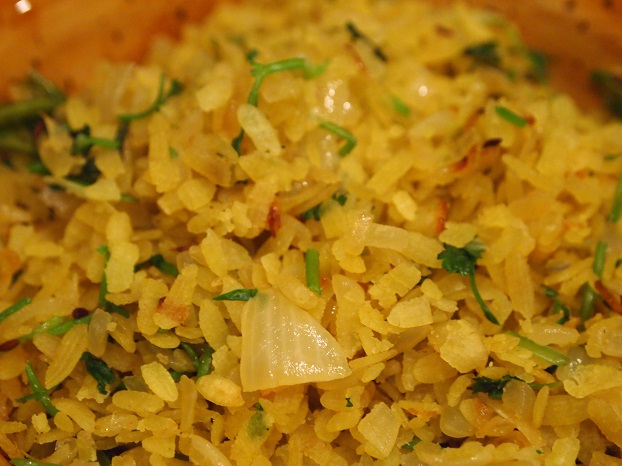
* * *
Sujatha Bagal is a Washington, D.C.- based freelance writer and blogger. Her essays, articles and stories have appeared in various online and print publications, including Pregnancy, Mint Lounge, ForbesLife India and The Smart Set (links available here). She is currently working with her mom-in-law on a cookbook featuring regional Karnataka cuisine. Find her onTwitter and Instagram.

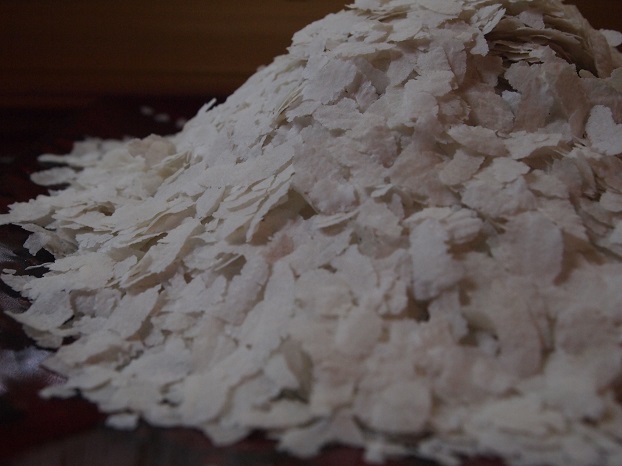












Thank you for this! My parents are from Karnataka and it was great to get this recipe, description, and story.